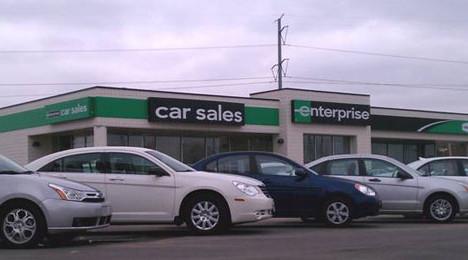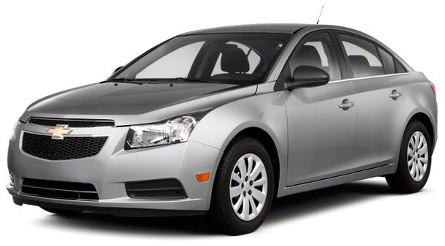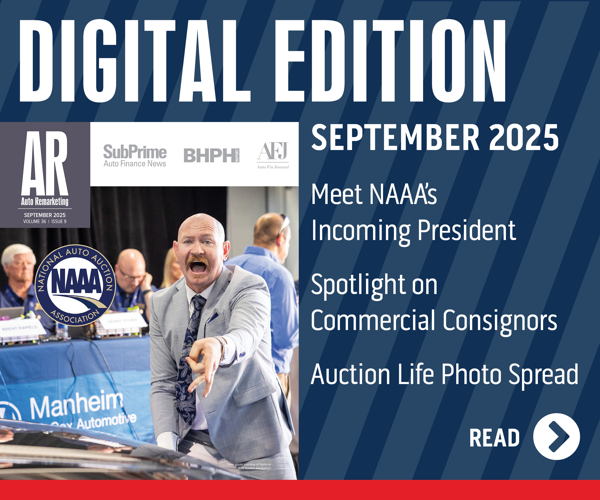With the proliferation of tablets and other technology that make consumers' lives easier, digitizing the F&I process can have lasting, positive impacts on customer satisfaction for dealerships, according to a new study from MakeMyDeal and F&I Express.
Titled, "The Digital F&I Experience Study," the study showed that consumers who had one or more digital elements in the F&I experience were more likely to purchase F&I products, be more satisfied with the experience and more likely to recommend the dealership.
Study orchestrators pointed out that much of the vehicle-shopping process has been digitized, either through online tools or desktop tools at the dealership. However, they acknowledged a significant portion of the process for automotive aftermarket insurance products still involves cumbersome printed documents and manually signed five-ply forms.
“As an industry, we know that the F&I experience is more difficult than it should be, but what we haven't had until now are the numbers to show how that experience could be affecting the long-term profit potential for the dealership," said Mike Burgiss, founder and vice president of MakeMyDeal.
“By digitizing the experience, dealers will not only have happier customers, but they'll also reap the benefits of more word-of-mouth recommendations and repeat business,” Burgiss continued.
The study grouped participants into two categories: those who had at least one electronic element in their F&I experience and those who had a traditional F&I experience.
Overall, the study indicated only a third — 37 percent — of people are completely satisfied with the amount of time they spend in the F&I office.
However, people who had an electronic experience reported higher satisfaction with their time spent in the F&I office than those who did not: 49 percent of people who had at least one digitized element in the process were completely satisfied, versus 34 percent of people who had no electronic elements.
Further, orchestrators mentioned stores that had an electronic element in the F&I experience reported greater purchase satisfaction and a stronger likelihood to recommend the dealer:
— Seventy-four percent of those with an electronic F&I experience were completely satisfied with their purchase experience versus 56 percent of those with a traditional F&I experience.
— Sixty percent of those with an electronic F&I experience said they were very likely to recommend the dealer versus 39 percent of those with a traditional F&I experience.
Brian Reed, chief executive officer of F&I Express, is helping lead the charge to digitize the F&I sales process.
“F&I is one of the few remaining areas of the dealership that hasn't been digitized, and this study clearly shows that there is a real need — and opportunity — for more of the process to be brought online,” Reed said
“Consumers have an expectation to have digital options for just about anything they are shopping for,” he continued. “Auto dealers have a chance to strengthen relationships with existing customers, and ultimately improve their profitability by shifting to a digital F&I strategy.”
In a move that came together since the companies do not have “philosophical differences on how to treat the customer,” Enterprise Car Sales now has the equivalent of a captive to help deliver its off-rental vehicles to buyers through a new multi-year, private-label agreement with Chase.
Under the agreement announced on Tuesday, Chase Auto Finance will be the private-label auto finance provider at more than 130 U.S.-based Enterprise Car Sales locations. Marketed and serviced under the name Enterprise Auto Finance, executives highlighted the offering will provide customers a financing experience that complements Enterprise’s award-winning customer service.
Officials indicated Enterprise Auto Finance will roll out later this year.
“Chase is pleased to provide Enterprise with a consistent source of funding and servicing as it continues to expand its car sales business,” Chase Auto Finance chief executive officer Thasunda Duckett said. “This is a great opportunity to deliver a world-class customer experience under the Enterprise Auto Finance brand.”
Chase has more than $60 billion in auto loans and leases for nearly 3 million customers in the U.S. and has relationships with more than 70 percent of all U.S. auto dealerships. The private-label path to vehicle financing certainly isn’t unfamiliar to Chase as it already has relationships with Mazda, Subaru, and Jaguar-Land Rover. But this week’s announcement marks Chase’s first alignment with a single retailer that might turn as much metal as Enterprise, which began selling used vehicles in St. Louis in 1962.
Bruce Jackson, head of retail lending at Chase Auto Finance, told SubPrime Auto Finance News, “We are always in constant dialogue with our clients about how we can better serve their needs and Enterprise is no exception.
“Enterprise has such a focus on customer service, as do we, so there really were no hurdles,” Jackson noted about the journey to this agreement. “It would have been tough if we had philosophical differences on how to treat the customer, but we did not, and the alignment will work well.
“The customer will have a consistent experience from Enterprise Car Sales to Enterprise Auto Finance. We will operate as an indirect lender for this program, just like we do for the other OEM programs we have,” Jackson went on to say.
Mike Bystrom, vice president of Enterprise Car Sales, explained why this program with Chase will help the company maintain its low-pressure, vehicle-buying experience and allows the Enterprise sales team to focus on that customer experience.
“We are excited to join with Chase to offer a private-label financing option for our customers,” Bystrom said. “We’ve enjoyed a strong partnership with Chase for many years. Our companies share a deep commitment to exceeding customer expectations, giving back to our local communities, supporting military veterans and their families, and putting the customer first.
“Chase is a natural fit to provide financing to our customers through Enterprise Auto Finance,” he added.
For more information about Chase Auto Finance, visit www.chase.com/auto-loans or www.chasedealer.com. For more information about Enterprise Car Sales, visit www.enterprisecarsales.com.
GWC Warranty chief executive officer and president Rob Glander insisted the company’s bread-and-butter customers are dealer clients who are those small- to medium-sized independent dealerships that might not move as much metal as the big franchised stores but still want to be successful.
So the vehicle service contract provider has been on a quest this year in particular being that its GWC’s 20th anniversary to give these operators all the tools necessary to make presentations, enhance customer relations and leverage technology.
“Basically, we want to reinforce our brand messaging that GWC is the best in class used vehicle service contract provider, and we do it by trying to help dealers sell more cars,” Glander told SubPrime Auto Finance News during a phone conversation this summer. “We do it by giving them tools, better service, better products, better training and technology.
“This is a way of putting our money where our mouth is,” Glander continued. “We’re committed to giving them technology that’s going to make them more efficient regardless of how comfortable they are with it. It also helps them project a much more progressive image to their customers.
“New-car dealers sell an awful lot of used vehicles as well. We want our standalone independent dealers to be able to play with the same sort of confidence and professionalism that a new-car dealer has when they’re selling these vehicles. It levels the playing field,” Glander went on to say.
It’s not uncommon for salespeople at those franchised stores to be circling the showroom with an iPad in hand ready to help customers. This summer, GWC rolled out its own app for tablets so independents can do the same thing.
The company highlighted the GWC App features:
— Educational video library
— Interactive coverage selection tool
— Real-time, reactive virtual shopping cart
— Mobile rating engine with VIN scanner to create a fast, easy, user-guided experience for selling vehicle service contracts
“With any technology there are going to be early adopters who are all over things. We do encounter dealers that have tablets in their stores and they’re trying to make use of them,” Glander said. “But we do business with an awful lot of small and medium-sized dealerships across the U.S. They don’t get the training and resources from people coming into their dealerships all the time and offering the most up-to-date tools and technology.
"They’re oftentimes out there on islands by themselves. With the pace of change being what it is, these people have to figure out what they’re going to embrace and have to do it with cost in mind, too,” he added.
GWC rolled out the iPad app ahead of this year’s National Independent Automobile Dealers Association annual convention so company representative could be armed with the technology not only at the NIADA event but also when varios state associations have their gatherings, too.
“We’ve been tablet users for a long time. We’re big Apple people in here,” Glander said. “We said there’s got to be a way to get this technology out there for our dealers. We knew Apple will sell 250 million iPads so you know they’re out there. So how do you play in there? How do you get this in front of dealers in a way that makes it useful for them?”
After brainstorming for several months, GWC generated its app concept and hired a service provider to build the tool with the final step in the process taking about six weeks.
Those four primary app features are coupled with capabilities such as the customers being able to see exactly what level of VSC would do to their monthly payment as well as an eContracting portal so the whole delievery can be completed in a paperless process.
“It makes it very user friendly. It helps the dealer be more efficient and progressive regardless of their comfort level with the technology,” Glander said.
New Benefits for Elite and WealthBuilder Dealers
Along with this summer’s app rollout, GWC Warranty also introduced two new value-added benefits exclusively for its Elite and WealthBuilder Dealers — GWC Virtual Training and Covideo.
GWC’s new Virtual Training platform is an interactive online video training tool that is designed to offer helpful content for every employee in a dealership. Available content topics include:
—Compliance
—F&I processes
—Sales strategies
—GWC product information and more.
Ideal for new employee ramp-up and legacy employee refresher courses, the company also highlighted GWC Virtual Training also boasts testing and reporting functions to maximize retention and track progress. This value-added tool is being offered free of charge to both Elite and WealthBuilder dealers.
Covideo is a customized, branded video email marketing service proven to increase internet response rates by 77 percent, showroom shows by 27 percent, customer satisfaction by 10 percent and sales by 7 percent. Glander pointed out that Covideo is easy to use on any computer or mobile device and is useful for lead follow up, vehicle walk-arounds, thank you videos for buyers and more.
GWC is sharing the cost of Covideo with Elite and WealthBuilder dealers to offer the service at a discounted rate – a price exclusive only to GWC Elite and WealthBuilder dealers.
“At GWC, we help dealers sell more cars by providing products, service, technology and training to help build upon their success,” Glander said.
“In Virtual Training, we are providing a training platform that levels the playing field for many independent dealers competing with larger stores,” he continued. “With Covideo, we are offering a high-tech tool aimed at helping dealers project a more modern, progressive image to current and potential customers.”
To sign up for either of these benefits, Glander explained that GWC Elite and WealthBuilder dealers simply need to contact their GWC dealer consultant.
Online Dealer Portal Celebrates First Anniversary
While the company as a whole turns 20, GWC Warranty also had another milestone this summer as it hit the one-year anniversary of its online Dealer Portal
In one year, the GWC Warranty Dealer Portal received more than 45,000 vehicle service contract submissions, evolving from an online tool for dealers to rate and submit contracts electronically to a comprehensive Web-based platform used by more than 4,000 dealerships nationwide.
With 220,000 logins in the first year alone, Glander noted that dealers have found value in the Dealer Portal’s numerous tools and resources by implementing its flexible functionality into their business’ everyday processes.
With a new release of the Dealer Portal, its list of features now includes:
—Prioritized, rapid-response online claims adjudication for Elite and WealthBuilder Dealers
—Free access to GWC’s Virtual Training Platform: an interactive, user-friendly training resource available exclusively to Elite and WealthBuilder Dealers
—An educational video library with streaming, on-demand content designed to aid in selling a VSC
—Real-time, fully historical “contracts and applications” reporting complete with claims summaries for every contract ever submitted
—A virtual content hub where dealers can download electronic product brochures, detailed component coverage information, cost of repairs statistics and more
—Instant access to frequently used forms and documents, such as a digital sales waiver and user guides for various sales like the GWC Dealer App for iPads
—A comprehensive, up-to-the-minute snapshot of past contracts and rating sessions
—The lead-generating LogoBuilder application that quickly and seamlessly brands dealership inventory with extended protection to help build confidence earlier in the sales process
Analysis compiled by Edmunds.com of used-vehicle financing activity during the second quarter at franchised dealerships turned up more evidence of the fuel igniting record-setting growth.
According to the site’s latest Used Vehicle Market Report, the average amount financed moved 3 percent higher year-over-year to $20,732.
“Loan terms are growing to offset higher prices but for the first time since pre-recession we are seeing average APRs creep higher,” Edmunds.com said about the average APR, which came in at 7.7 percent.
“While nearly 60 percent of used buyers financing their vehicle obtained an APR of 5 percent of lower, many buyers have APRs in excess of 10 percent,” the site continued in its reported, which also mentioned the average used-vehicle retail prices hit a record high in Q2.
Edmunds also pointed out that the average term for a used-vehicle installment contract originated at the franchised store during the second quarter climbed to 66.2 months, extending an upward march that began in 2009.
Beyond the rising retail prices, Edmunds.com director of industry analysis Jessica Caldwell told SubPrime Auto Finance News during a phone conversation on Friday that another elements is pushing the APR average higher.
“My feeling is some of the folks in the subprime market are driving up the averages,” Caldwell said. “It is a law of averages because the majority are paying a lower interest rate. But for every person who is getting a 2 percent APR, there is someone paying 25 percent. It definitely affects the averages.”
All of that used-vehicle activity at franchised dealerships — subprime or not — helped to push the industry to a new record in Q2.
According to the New York Federal Reserve’s Consumer Credit Panel, a nationally representative sample drawn from anonymized Equifax credit data, auto loan originations reached a 10-year high in the second quarter at $119 billion, supporting a $38 billion increase in the aggregate auto loan balance.
That balance is now above $1 trillion, which Equifax deputy chief economist Dennis Carlson discussed with SubPrime Auto Finance News in more detail.
More discussion about how the subprime slice of the auto finance market is behaving is on tap for the SubPrime Forum, which is a part of Used Car Week. Analysts and experts from the leading data and compliance providers are set to be a part of the event, which runs from Nov. 16-20 at the Phoenician in Scottsdale, Ariz.
For more details, go to www.usedcarweek.biz.
Special finance software solution provider ProMax Unlimited reviewed dealership data from July and compiled the top 20 highest grossing vehicles in three different subprime credit tiers.
The three lists should be especially helpful for dealerships and finance companies that originate deliveries associated with models from Chevrolet, Hyundai, Ford and Dodge
In a blog post, ProMax Unlimited noted that vehicles are ranked in order of total units sold, not total gross:
Credit Tier 575-619
1. 2013 Hyundai Elantra: $2,646.98
2. 2013 Chevrolet Cruze: $3,600.26
3. 2013 Kia Soul: $3,218.34
4. 2013 Chevrolet Malibu: $2,981.18
5. 2013 Ford Fusion: $2,920.35
6. 2013 Chrysler 200: $2,524.60
7. 2013 Dodge Avenger: $2,250.00
8. 2013 Dodge Grand Caravan: $2,886.46
9. 2013 Hyundai Sonata: $2,946.06
10. 2014 Chevrolet Cruze: $3,852.71
11. 2011 Chevrolet Malibu: $2,788.54
12. 2013 Kia Optima: $2,784.82
13. 2012 Ford Fusion: $2,135.75
14. 2013 Ford Focus: $4,494.38
15. 2012 Chevrolet Cruze: $3,627.27
16. 2012 Toyota Camry: $3,001.35
17. 2013 Chevrolet Sonic: 2,759.05
18. 2012 Chevrolet Malibu: $3,102.32
19. 2012 Ford Focus: $2,266.01
20. 2013 Chevrolet Impala (Fleet): $2,230.22
Credit Tier 520-574
1. 2013 Ford Fusion: $3,137.13
2. 2013 Dodge Avenger: $1,727.26
3. 2013 Hyundai Elantra: $2,982.77
4. 2012 Ford Focus: $1,739.23
5. 2013 Chevrolet Cruze: $2,267.88
6. 2013 Chevrolet Impala (Fleet): $2,195.01
7. 2013 Hyundai Sonata: $2,206.30
8. 2012 Ford Fusion: $3,013.60
9. 2013 Kia Soul: $2,956.19
10. 2012 Nissan Altima: $2,778.23
11. 2014 Chrysler 200: $2,623.67
12. 2012 Chevrolet Cruze: $2,203.18
13. 2013 Chrysler 200: $1,829.98
14. 2014 Nissan Altima: $2,923.39
15. 2013 Dodge Grand Caravan: $2,250.34
16. 2014 Ford Fusion: $1,861.77
17. 2014 Chevrolet Cruze: $1,653.25
18. 2012 Chevrolet Malibu: $2,483.58
19. 2013 Chevrolet Malibu: $1,718.37
20. 2013 Ford Escape 4WD: $3,463.21
Credit Tier 460-519
1. 2013 Dodge Avenger: $2,766.95
2. 2013 Hyundai Elantra: $1,902.93
3. 2013 Chevrolet Malibu: $745.25
4. 2011 Ford Fusion: $1,357.39
5. 2013 Nissan Altima: $2,544.57
6. 2013 Chrysler 200: $2,208.38
7. 2014 Chevrolet Cruze: $3,519.93
8. 2012 Ford Fusion: $2,231.35
9. 2012 Chevrolet Malibu: $3,351.51
10. 2012 Nissan Altima: $3,582.73
11. 2014 Nissan Altima: $2,601.81
12. 2014 Chrysler 200: $1,934.95
13. 2013 Chevrolet Impala (Fleet): $1,456.55
14. 2013 Kia Optima: $2,612.91
15. 2013 Chevrolet Cruze: $2,473.77
16. 2013 Dodge Dart: $2,716.96
17. 2013 Ford Fusion: $2,652.25
18. 2014 Toyota Corolla: $2,404.98
19. 2013 Ford Focus: $2,715.42
20. 2013 Kia Soul: $2,104.89
A day after the latest auto loan default data showed only marginal movement, TransUnion reported on Wednesday that its information shows the national auto loan delinquency rate declined to its lowest level in two years.
TransUnion’s auto delinquency rate — the ratio of borrowers 60 days or more delinquent on their vehicle installment contracts — dropped to 0.95 percent in the second quarter, down 3.1 percent from 0.98 percent a year earlier.
Analayts mentioned that auto delinquency rates now are at the lowest level since Q2 2013, when delinquency rates dropped to 0.86 percent.
While the overall reading is showing a positive trend, TransUnion carved out an analysis in the subprime space, too, and found similar delinquency behavior unfolding.
Delinquency rates for subprime borrowers — those consumers with a VantageScore 3.0 credit score lower than 601 — continued their steady decline, settling at 4.98 percent in Q2. The reading marked a 1.6-percent year-over-year decline from 5.09 percent in Q2 of last year.
On a quarterly basis, delinquency rates for subprime consumers declined 4 percent from 5.19 percent in Q1 of this year.
TransUnion found that nearly 72.5 million consumers have an auto loan or lease as of Q2 with nearly one-fifth (18 percent) of those consumers in the subprime risk tier.
Despite the 13.1 million subprime consumers with auto loans, subprime participation remains below the 23.7 percent level observed in Q3 2009 coming out of the Great Recession.
“Lenders are being prudent about re-entering the subprime lending market, and consumers are effectively managing their loans as delinquency rates remain stable,” said Jason Laky, senior vice president and automotive business leader for TransUnion.
“In today’s lending environment, we’re seeing consumers across all risk tiers take advantage of low rates. Super prime consumers, typically a group with greater wherewithal to purchase their cars for cash, are also financing their cars with more frequency,” Laky said.
Of the 72.5 million consumers with an auto loan or lease, TransUnion determined 16.8 million belong to the super prime risk tier — those consumers with a VantageScore 3.0 credit score 780 or higher. More than 23.3 percent of all auto loans are held by super prime consumers, an 8.2-percent year-over-year increase from Q2 of last year.
Viewed one quarter in arrears (to ensure the large majority of accounts are reported and included in the data), TransUnion discovered new auto loan originations increased 4.3 percent year-over-year to 6.5 million in Q1, up from 6.2 million in Q1 of 2014.
On a quarterly basis, auto originations increased 5.3 percent from 6.1 million in Q4 of 2014.
Analysts noticed auto loan debt per borrower grew 3.4 percent to $17,696 in Q2 2015. They pointed out the growth moderated across all risk tiers on a year-over-year basis, with the slowest pace of growth since Q2 2012.
“While growth rates have slowed progressively throughout the past two years, we are still in a high growth period,” Laky said. “Demand for auto loans was pent up during the Recession, and we’re seeing a return to a normal momentum.”
The youngest consumer group — individuals age 30 and younger — experienced growth in average balance for open auto trades in Q2. Up from $14,778 in Q2 of 2014, TransUnion indicated the average balance was $15,200 in Q2 of this year, an increase of $423.
Analysts went on to mention nearly 831,000 more young consumers had an auto loan in Q2 of this year than in Q2 of last year. Despite this increase, TransUnion pointed out delinquency rates remained stable from Q2 2014 (1.27 percent) to Q2 2015 (1.28 percent).
Looking at the data geographically, TransUnion noticed only two of the nation’s largest cities experienced an increase in auto loan delinquency in Q2. Houston (up 5.4 percent from 1.11 percent in Q2 2014 to 1.17 percent in Q2 2015) and Washington D.C. (up 5.1 percent from 0.79 percent in Q2 2014 to 0.83 percent in Q2 2015) experienced rises, while Boston remained unchanged at 0.59 percent for both Q2 2014 and Q2 2015.
On a state level, TransUnion reported delinquency rates in 33 states declined in Q2. Oklahoma (down 17.2 percent from 1.66 percent in Q2 2014 to 1.37 percent in Q2 2015) and Illinois (down 11.9 percent from 1.01 percent in Q2 2014 to 0.89 percent in Q2 2015) experienced double-digit declines in their year-over-year delinquency.
Analyts added that all states had an increase in auto loan debt per borrower in Q2, with New Mexico (up 5.9 percent from $20,387 in Q2 2014 to $21,586 in Q2 2015) and Georgia (up 5.2 percent from $18,312 in Q2 2014 to $19,258 in Q2 2015) experiencing the largest rises.
“The auto loan market continues to be fueled by new account growth, higher balances financed and low delinquency rates,” Laky said. “We’re observing low delinquency rates in major U.S. cities and many states, indicating a positive lending environment.”
This information is reported by TransUnion and is part of its ongoing series of quarterly analyses of credit-active U.S. consumers and how they are managing credit related to mortgages, credit cards and auto loans.
Thanks to technology, today people look for speed and efficiency in everything they do more than ever before — and the car buying process is no exception.
Carrying the stigma of being time-consuming, even called “painful” by customers, how can dealers and lenders make the process of purchasing a car faster, more efficient and a better experience for today’s shopper? The answer could be found in the use of eContracting technology. eContracting, or electronic contracting — which can now be conveniently conducted using iPads/tablets in Wi-Fi connected showrooms — creates efficiencies in the F&I process and expands the possibilities of increased profitability, in both the short term and long term.
According J.D. Power’s 2015 U.S. Dealer Financing Satisfaction study, more than half of surveyed dealers indicate faster funding as the main reason they use eContracting. Additionally, the study found that when dealers use lender-provided eContracting, their overall satisfaction averages 913 on a 1,000-point scale, compared with 856 when lenders don’t provide eContracting. As critical aspects of the automotive retail workflow evolve with technology, dealerships and the lenders they do business with are beginning to see these efficiencies come to life.
Faster contract funding is a perfect example: Long the domain of the traditional sales and lending approach, today there's strong evidence that the shift to eContracting is accelerating, as dealers and lenders discover its effectiveness. In fact, we have seen a consistently steady increase in eContracting activity year-over-year, and nearly a 20 percent jump since 2014 alone. Dealers aren’t looking back, and neither are lenders: According to Dealertrack surveys, 98 percent of dealer personnel using electronic contracting plan to continue to use the software, and 93 percent would recommend eContracting to their peers. On the lender side, there’s been a healthy increase in electronic contracting adoption, with 20 lenders already on the program, and more planning to support the workflow in the near-term. With key findings from the J.D. Power survey that found lenders can expect on average a 39 percent increase from the dealers with whom they do business – eContracting is no longer the chicken-or-egg scenario it once was.
Not surprising, it has been reported by industry media that 80 percent of all U.S. dealerships will adopt eContracting within five years. And the reason is simple.
The benefits of eContracting are game-changing:
• It speeds up the process of contracting from days to hours. eContracting can help make funding possible within two to three hours. Dealertrack surveys also show that contract processing turnaround times ranked fourth in importance by dealers when choosing a lender partner.
• It improves accuracy. The process of eContracting includes verification engine drivers that catch errors beforehand, so contracting is fast and efficient. Often in the manual process, at best these errors slow the process down while the dealer looks to fix what’s wrong or missing, and at worst are caught too late and lead to recontracting.
• Mobile review and signing functionality takes efficiency and convenience to the next level. With an iPad or Android tablet, the Dealertrack mobile app and Wi-Fi in the showroom, dealers and customers can review and sign contracts anywhere in the showroom they are most comfortable. The contract appears in full form on the device, eliminating the need for forced print review, and signing is easy – dealers and customers sign once, then tap to apply their signatures directly in the form where required.
This movement toward a technology-enabled, mobile and flexible process brings added convenience to a dealership’s workflow. eContracting is a great example of the technology enhancements that are immensely improving the overall buyer experience, so critical to dealers’ retail process and business success. The surge in adoption of eContracting demonstrates the point of good technology: to simplify and evolve the act of buying and selling cars into an efficient, profitable and consumer-friendly experience. For Dealertrack, it’s another solution-based catalyst we offer to help transform the automotive retail experience.
Michael Collins is senior vice president, lender and F&I solutions for Dealertrack Technologies. In this role, Collins has executive responsibility and oversight for the strategic planning & execution of software and transaction channel services to automotive dealers across the U.S. in the area of finance and insurance as well as a variety of showroom and sales software solutions. This includes Dealertrack’s credit application and aftermarket networks, which are the largest in the industry, connecting franchised and independent automotive dealers to more than 1,500 finance and other strategic partners. Collins is on tap to be one of the keynote speakers during the SubPrime Forum at Used Car Week, which runs on Nov.16-20 at the Phoenician in Scottsdale, Ariz.
Perhaps another component of why credit unions are so aggressive in expanding their auto portfolios is their collective relationship with dealerships is as good as it’s ever been. That’s the sentiment conveyed by CU Direct executive vice president Jerry Neemann when SubPrime Auto Finance News connected with him shortly after TransUnion released its annual survey of credit union executives, who expressed their optimism about auto originations and performance.
Neemann based his assessment on the steady improvement during the past 20 years of CUDL, the network that now includes close to 12,000 dealerships that work with 1,100 credit unions.
“What’s happened during that time is we’ve gone through a lot of evolutions. The dealership business model has adapted, and the credit union model is a very valuable partner for dealers,” Neemann said. “It gives them excellent locations to go to get paper bought. It opens more channels of comparative lending to find a home for the loan.
“The additional benefit value that’s been worked on during this time is truly credit unions are a membership-based organization,” he continued about the institutions currently leveraging CUDL that now have about 45 million consumer members.
Neemann explained the relationship between dealerships and credit unions function because it’s a “push-and-a-pull type of environment.” Not only are F&I managers sending applications to credit unions, but buying-assistance programs utilized by the institutions are also sending leads to the showroom.
“The business model and relationships that have been created are creating that kind of volume and value for both parties,” Neemann said.
Experian Automotive reported that credit unions held 16.94 percent of the auto finance market after the first quarter, representing a 7.6-percent rise year-over-year.
The TransUnion survey indicated just how much credit unions want to expand their auto portfolios. TransUnion’s survey revealed that auto loans rank at the top of the list for credit union executives in terms of loan growth, focus and opportunity during the next 12 months. Auto loans were ranked No. 1 by 48 percent of credit union executives and in the top 3 (of 12 credit categories) by 81 percent of respondents.
“Auto lending is one of the cores of what they do,” Neemann said. “As they build up a book of business, it’s continuing to grow. You always have run-off of your earlier loans. There’s always a need to continue originating to grow and replace your portfolio that’s running off. They’re highly motivated and strong in the market. I see our growth continuing. We will be a strong player.
“Members aren’t going anyway. As part of that equation, they’re always buying cars. The credit unions are there to lend their money to the members. Both pieces are working on an ongoing basis,” he went on to say.
Neemann acknowledged it’s not quite an “apples-to-apples comparison,” but he calculated that if you added together the collection origination volume and outstanding portfolio of the credit unions involved with CUDL, the figure would only trail some of the largest single auto finance market holders such as Wells Fargo and Ally Financial.
To get that kind of volume, Neemann insisted that credit unions in the CUDL network perform with the efficiency of a single institution such as Wells Fargo or Ally, not 1,100 different organizations that might have varying underwriting criteria. CUDL streamlines some front-end and back-end elements so dealers can know immediately know if the deal has been purchased, some modifications need to be made or if the application has been declined.
That speed of response is what J.D. Power recently found as being paramount to dealers.
Neemann also mentioned the ability of CUDL’s processing solution, Smart Fund, which can allow managers to upload the entire deal jacket electronically. A credit union processor can perform quality control tasks to ensure all document are included, alert the dealership if anything is missing and complete the funding process so money is in the store account usually in about 24 hours.
“Funding for the dealer as we all know is very critical. That’s about as efficient as it can get,” Neeman said.
TransUnion’s data shows credit union auto loan origination volume grew at a rate more than double the pace of the entire industry. Findings from a survey of 90 credit union executives TransUnion released this week also highlighted these institutions’ appetite for auto paper certainly isn’t waning; it's perhaps even becoming greater.
TransUnion’s survey revealed that auto loans rank at the top of the list for credit union executives in terms of loan growth, focus and opportunity during the next 12 months. Auto loans were ranked No. 1 by 48 percent of credit union executives and in the top 3 (of 12 credit categories) by 81 percent of respondents.
“Auto loans have proven to be one of the key growth opportunities for credit union executives in the past and should continue to do so in the future,” said Nidhi Verma, director of research and consulting in TransUnion’s financial services business unit.
“Auto loans are especially appealing because of the high demand for both new and used vehicles, as well as continued low delinquency rates,” Verma continued.
When Verma compared the survey results with the origination data TransUnion has available, she told SubPrime Auto Finance News that “clearly the messages are pretty tied together.”
From the first quarter of last year to the first quarter of this year, TransUnion reported a 7.4-percent increase in new auto loans issued by credit unions, while the rest of the industry saw a 2.1-percent increase in the same timeframe.
Verma also pointed out that subprime constituted 12.5 percent of all new loan originations in Q1 2015 for credit unions. This was similar to the 13.1 percent subprime share of originations in Q1 2014.
“There’s been a lot of conversation in the industry about subprime originations,” said Verma, who made a presentation in Las Vegas this week during a seminar TransUnion hosted for the credit union industry.
“Credit unions continue to be relatively conservative compared to the rest of the industry with approximately half the size of the subprime auto lending market,” she continued.
“Credit union delinquency rates are half the rate of the rest of the industry, which is a reflection of how credit unions manage risk distribution in this market,” Verman went on to say. “That’s one of the core differences that’s helping their delinquency rates.”
TransUnion also found that the duration of vehicle installment contracts credit unions are booking is lengthening.
In Q1 2010, 32 percent of credit union auto loans were originated with duration of more than 60 months. By Q1 2015, that percentage had risen to 47 percent.
TransUnion noted approximately 39 percent of survey respondents said that more than half of their auto loan originations are 60 months or greater in length.
“These data points clearly show that greater loan lengths are one of the drivers of growth in the auto market,” Verma said.
“In the current low interest rate environment, longer loan durations allow consumers to buy new or used cars with lower monthly payments that fit within their budget,” she went on to say. “The increase in loan durations shows lenders are meeting those consumer needs.”
After sharing the data and survey results, Verma explained that credit union executives should be in a better place to make decisions.
“If I’m a credit union and I’m developing a strategy for my auto business, you’re forming your strategy at one point in the year so you know where the capital investment is going on for the next 12 months,” Verma said. “We like to tie our survey and data into that strategic investment philosophy.”
Editor’s note: Watch for a future report in SubPrime News Update where CU Direct executive vice president Jerry Neemann offers his assessment of how credit unions and dealerships are working together more than ever to improve sales and originations.
Santander Consumer USA Holdings evidently isn’t rattled by the Consumer Financial Protection Bureau turning over allegations to the Department of Justice about how the finance company conducts its business.
SCUSA shared details about the pair of allegations the CFPB made as part its regulatory filing with the Securities and Exchange Commission posted earlier this week. SCUSA said that on July 31 the CFPB notified the finance company that specializes in subprime originations while also being the backbone for Chrysler Capital that the bureau referred certain alleged violations of the Equal Credit Opportunity Act to the Justice Department. The alleged infractions stemmed from:
— Statistical disparities in markups charged by dealers to protected groups on loans originated by those dealers and purchased by SCUSA
— Treatment of certain types of income in the company's underwriting process
The notification about the CFPB moves arrived a day after the company reported its second-quarter performance, which included total originations of more than $7.6 billion.
In its SEC filing, SCUSA said, “The company does not believe that there are any proceedings, threatened or pending, that, if determined adversely, would have a material adverse effect on the consolidated financial position, results of operations, or liquidity of the company.”
Since the CFPB allegations officially hadn’t come to light when SCUSA, investment analysts didn’t probe the company about them. However, when asked about the company’s strategy, new chief executive officer Jason Kulas reiterated much of the same tenor he used when he ascended into his current role at the beginning of July, replacing co-founder Thomas Dundon.
“We are having a lot of discussions about strategy and not just among our management team but also with our board,” Kulas said when the company hosted its second-quarter conference call.
"The level of dialogue we are having is real positive,” he continued, according to a transcript posted by SeekingAlpha.com. “I think one thing that is important to talk about in answering that question is the connection between our former CEO and me and the ongoing dialogue we have been having about this business for over 20 years. Many aspects of the strategy of this business were developed together with Tom and I discussing the business literally every day for a long period of time.
“So for that reason, I don't expect a lot of big changes in strategy,” Kulas went on to say. “We saw the business eye to eye. We developed and grew the business together, and I believe in the strategy that we have, which is at its core, what we always talk about. That's just making sure that every single loan we originate has the right price and the right structure so the company continues to be positioned to perform through cycles.”
Perhaps SCUSA’s strategy is working nicely since the company’s total originations came in at more than $7.6 billion during the second quarter, up from $7.4 billion a year earlier. The most recent figure includes $2.7 billion in Chrysler Capital retail installment contracts, $1.4 billion in Chrysler leases originated for its own portfolio and $229 million in Chrysler lease originations facilitated for an affiliate.
The company also highlighted that other originations, including other auto and personal loans, totaled $3.3 billion for the second quarter. Kulas pointed out that Q2 auto originations continued to see a seasonal benefit due to the tax refund season.
The activity propelled SCUSA to a Q2 net income figure of $285.5 million, or $0.79 per diluted common share.
“Our company achieved strong results this quarter, producing a 16 percent year-over-year growth in net income,” Kulas said in a company statement. “This evidences our robust business model and our team’s ability to produce results.
We continued to execute against our stated strategy of optimizing the mix of retained assets versus assets sold and serviced for others by originating more than $7.6 billion and selling more than $2.8 billion in assets, further strengthening our balance sheet while growing our consumer finance marketplace,” he continued.
“We are confident the effective execution of this strategy will lead to continued growth in the serviced for others portfolio while generating attractive balance sheet returns as well as capital-light fee income,” Kulas went on to say.











